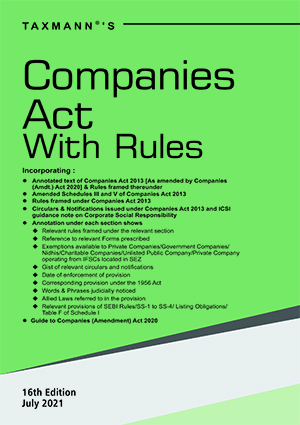Steps in Formation of a Company under Companies Act 2013
- Blog|Company Law|
- 3 Min Read
- By Taxmann
- |
- Last Updated on 29 November, 2021
Company Formation under the Companies Act, 2013
Under this act, a company may be formed for any lawful purpose by seven or more members to incorporate a public company and two or more members for a private company or by a single person as One Person Company. The company must subscribe its names into a memorandum and must comply with all the registration requirements under the Companies Act, 2013.
Memorandum of a Company
The Memorandum of a company should state the name of the company with last word as “limited” in case it is a public limited company and “Private Limited”, in case it’s a private limited company. Then they must mention the state in which the registered office of the company will be situated, the objects of the company, and liability of various members of the company. In case of a company is limited by the shares, then the liability of its members is limited to the unpaid amount or the shares they hold. In case the company is limited by a guarantee, then the amount of each member’s contribution towards the assets of a company, if the company is wound up or he ceases to be a member of the company within one year of formation of the company. Or else each member shall contribute towards the costs, charges, and expenses of winding up or adjustments of rights towards the contributions should be made amongst themselves. The name stated in the memorandum should be unique and should not be identical or resemble very closely to any existing company which is already registered under the Companies Act, 2013. Also, the company cannot be registered with a name that has a word or expression which gives an impression of it being connected in any way to the patronage of Central Government, or State Government or local authority, or any corporation or body which is constituted by it. The memorandum must be in forms as specified in Tables A, B, C, D, and E of Schedule I as applicable to such company.
 Article of a Company:
Article of a Company:
Then a company must also have articles that must contain the regulations for its management and should have provisions to be adjusted later by following the prescribed procedure. It should also define the procedure to adjust these articles. The articles must be presented in forms as specified in Tables F, G, H, I, and J of Schedule I as applicable to such a company. It’s up to the company to opt for some or all the regulations which are contained in the model article which is applicable to that company.
Related Articles:
Disclaimer: The content/information published on the website is only for general information of the user and shall not be construed as legal advice. While the Taxmann has exercised reasonable efforts to ensure the veracity of information/content published, Taxmann shall be under no liability in any manner whatsoever for incorrect information, if any.

Taxmann Publications has a dedicated in-house Research & Editorial Team. This team consists of a team of Chartered Accountants, Company Secretaries, and Lawyers. This team works under the guidance and supervision of editor-in-chief Mr Rakesh Bhargava.
The Research and Editorial Team is responsible for developing reliable and accurate content for the readers. The team follows the six-sigma approach to achieve the benchmark of zero error in its publications and research platforms. The team ensures that the following publication guidelines are thoroughly followed while developing the content:
- The statutory material is obtained only from the authorized and reliable sources
- All the latest developments in the judicial and legislative fields are covered
- Prepare the analytical write-ups on current, controversial, and important issues to help the readers to understand the concept and its implications
- Every content published by Taxmann is complete, accurate and lucid
- All evidence-based statements are supported with proper reference to Section, Circular No., Notification No. or citations
- The golden rules of grammar, style and consistency are thoroughly followed
- Font and size that’s easy to read and remain consistent across all imprint and digital publications are applied




 CA | CS | CMA
CA | CS | CMA
